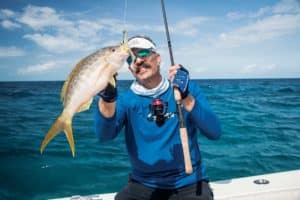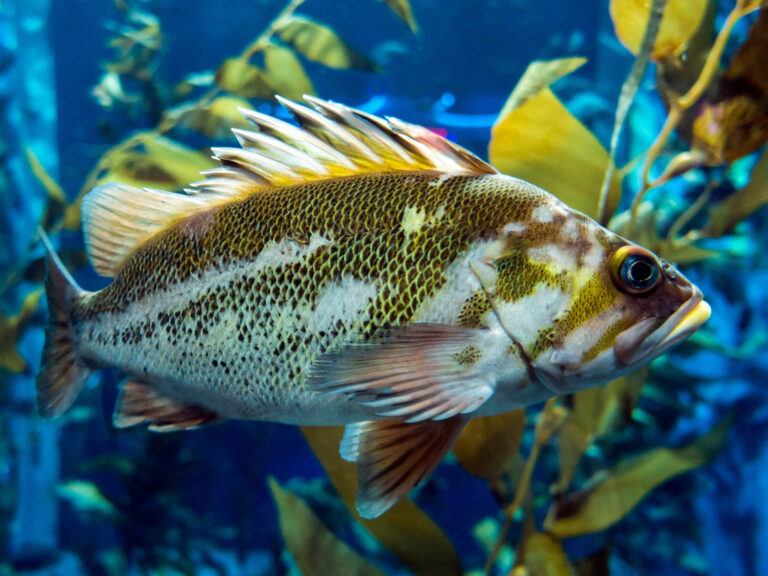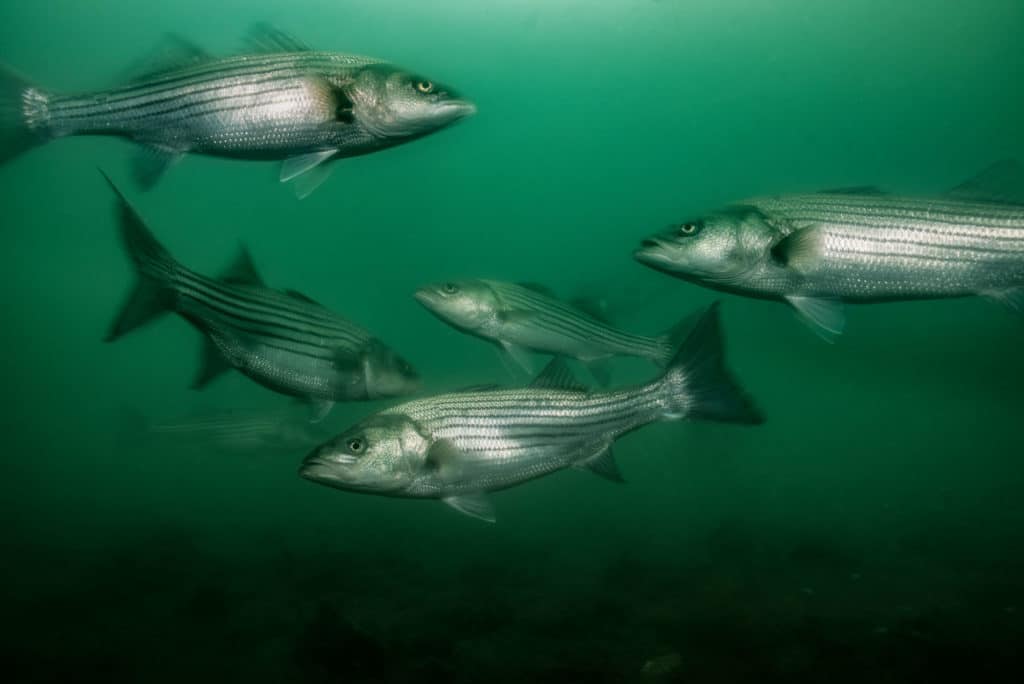
Most of us are familiar with the adage, “All fishermen are liars.” But occasionally an outing is so grand, you don’t need to lie about it. We actually had many such days this past season, starting with our first trip of the year in late spring. A light southwest breeze tufted western Long Island Sound as my buddy Elliott Taylor and I accelerated out of Branford Harbor from the Connecticut shore. We made a turn to the south and headed toward Branford Reef, 4 miles away. As we closed within a half-mile of our destination, we spotted the unbelievable: a 50-acre swath of working birds and breaking fish. And only two other boats were on them.
By the time we had reached the ledge and motored up-current of the structure, the depth-finder screen showed almost solid red from all the life below us, and schoolie striped bass were busting all around. For once, pinpointing a rip’s “sweet spot” didn’t matter — the entire expanse was one giant sweet spot, and we scrambled to get our tackle in the water as if we might miss the bite.
Taylor grabbed his spinning outfit and flung a large, chrome Kastmaster into the nearest melee while I went with my light conventional outfit rigged with a 4-ounce diamond jig below a soft-plastic dropper. I free-spooled toward the bottom but never reached it.
“Fish on!” Taylor called, as he pulled back on the rod to set the hook, adding, “Beat you — I hooked the first fish.”
Moments later, as Taylor released his fish, I boated a double-header, one on the jig and a second on the dropper hook above it.
“You got the first,” I admitted, “but I’ve caught more. Holy moly, this is amazing!”
And it was amazing. We were drifting across an area that held a mass of small stripers stacked like cords of firewood. The bottom composition and depth didn’t matter, with baitfish dispersed throughout the water column. Almost every drop or cast produced multiple hits, so it became a challenge to retrieve a lure without catching a fish. This fishery, as in other recent years, lasted most of the season.
“On Veterans Day,” says Connecticut marine fisheries biologist Justin Davis, Ph.D., “I took a trip out of Niantic in eastern Long Island Sound. The birds and fish started about halfway out of the bay and continued east almost to the mouth of the Thames River in New London — about 3½ miles. It was incredible. There were schools of thousands of fish all over the place. A couple of times, I just stopped casting and stood on the bow to watch.”
Even the most dedicated trophy-bass angler would abandon his hunt for the amazing action that school-size fish can offer, for those who know how to find them.
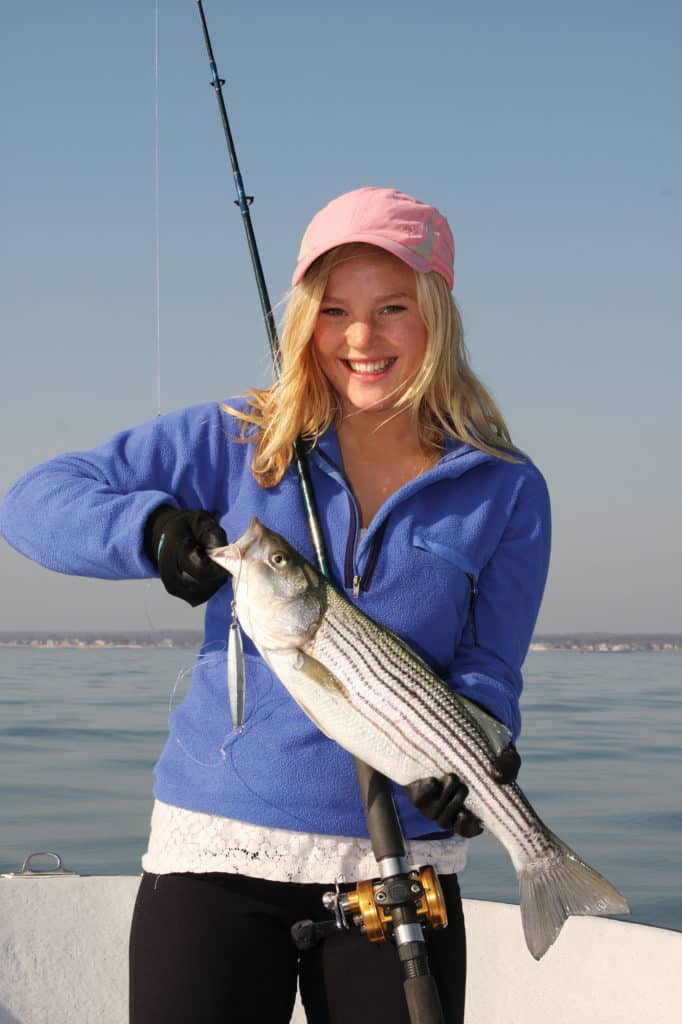
The Schoolie Niche
“Schoolie” bass earn their nickname because small stripers feed and travel in coherent schools. Once they reach the 3-foot-long range, they gradually become more independent, and true trophies, or “cows,” are solitary, opportunistic predators.
“When the bite is on,” says Capt. Dixon Merkt, who — retired after guiding for more than 45 years out of Old Lyme, Connecticut — now fishes for fun, “the number you can catch is almost unlimited. But you’re not casting to individual fish; you’re seeking schools where you get hits cast after cast after cast. These bass are cookie-cutter fish where volume is your objective, not size. Reports of two anglers releasing 75 to 100 fish on one tide aren’t uncommon.”
Unlike other inshore species in southern New England, such as bluefish and tautog, schoolies — loosely defined as those stripers up to the 28-inch minimum legal length — are active before the water temperature reaches 50 degrees, and these fish stay active well below the 50-degree point in late fall. This is a largely untapped sporting opportunity for anglers looking for early- and late-season action to replace dwindling numbers of cool-water targets such as cow bass, winter flounder and blackfish.
“In spring,” says Capt. Chris Elser, an expert with nearly 30 years of guiding experience, “most of the schoolie stripers near my home port of Stratford (Connecticut) are products of the resident Housatonic River holdover fishery, but we do see migratory fish arriving by mid- to late May most years. Late in the season, I’ve had crazy action in open water as late as the middle of December. Of course, that’s weather permitting, and the past several seasons have started late or been cut short by cold and wind.”
Elser continues: “We’ve had excellent action on light tackle outside the river between West Haven and Norwalk, where we’ve found huge schools of 12- to 28-inch stripers in 30 to 50 feet of water. They’re feeding near the surface on small baits. The birds are the clue, and they make it easy to find the fish. On a good day, we can land more than 100 bass.”
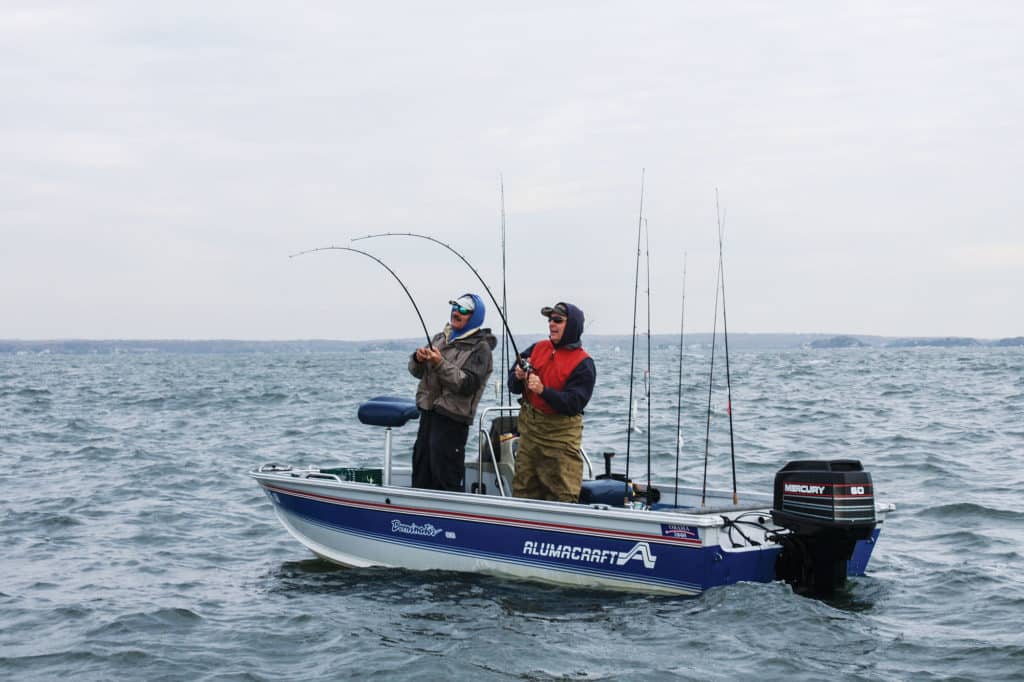
Population Shift
Anglers, guides and biologists have observed a recent and troubling decline in big-bass numbers since their resurgence 20 years ago. Several factors are implicated, including black-market harvesting, excessive commercial landings, lack of adult menhaden, mycobacteriosis disease, a shift in migration patterns, and predatory seals.
“I still see large bass in our region,” Elser says, “but they’re not as widespread as 10 years ago, and there aren’t as many 30-plus-pound fish. Also, more big fish are migrating via the South Shore side of Long Island versus passing through Long Island Sound. But I believe the current limit of one fish of 28 inches or larger is OK to keep the population healthy. Most of the anglers I know practice catch-and-release for stripers of all sizes, though I see nothing wrong with taking a good eating-size fish of 28 to 32 inches — which sometimes mix with the schoolies — home for the table. The big breeders should be quickly and carefully released.”
The lack of large bass isn’t restricted to Long Island Sound; captains are seeing similar problems along the entire Northeast coast, starting with neighboring Rhode Island.
“There’s an absolute decline in big-bass numbers,” says Capt. Chris Willi, who has guided around Block Island, Rhode Island, for more than 25 years and owns Block Island Fishworks. “Block Island is arguably the epicenter for big striped bass, but the consistency isn’t like it used to be. We had an epic year in 2014, with masses of fish of 30 to 50 pounds on the famed Southwest Ledge, but it’s been slow going since.”
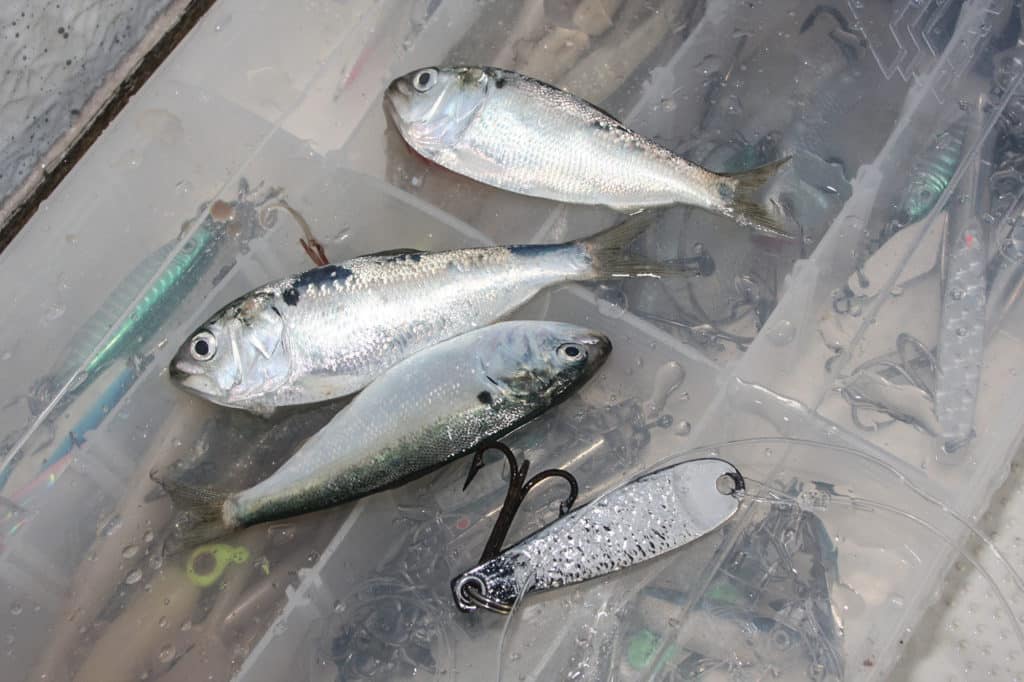
Forage Species
So many schoolie predators in an area require an abundance of small prey, which southern New England has been fortunate to be able to provide. Bass target what’s available, and the forage base changes by season and region.
“In western Long Island Sound,” Elser says, “as May rolls in, so do sand eels, the primary bait source creating the inshore fishery that light-tackle anglers crave. The fall fishery depends on the arrival of peanut bunker and bay anchovies, and we’ve had consistent schoolie striper action for many years now during late September through the end of October. From November into December, when the weather allows, herring, butterfish and occasionally mullet keep schoolie and larger bass interested.”
The usual summer doldrums didn’t set in this past season in eastern Long Island Sound, with a mass of tens of thousands of schoolie bass staging in the famous Sluiceway, a rip at the mouth of the sound, through late July. This remained a closely guarded secret for the first few weeks. “They were on small herring in the Sluiceway,” says Capt. Dan Wood, a longtime top guide in the eastern sound. “It was a wonderful opportunity for experienced and inexperienced customers to get into great action. They didn’t need to cast well or far to reach the fish.”
Along the big islands such as Block and Nantucket, types of baitfish similarly vary. “Our primary forage for bass is sand eels in spring and fall,” Willi says, “and we have squid throughout the season. Silversides move in during August into September to round out the feast.”
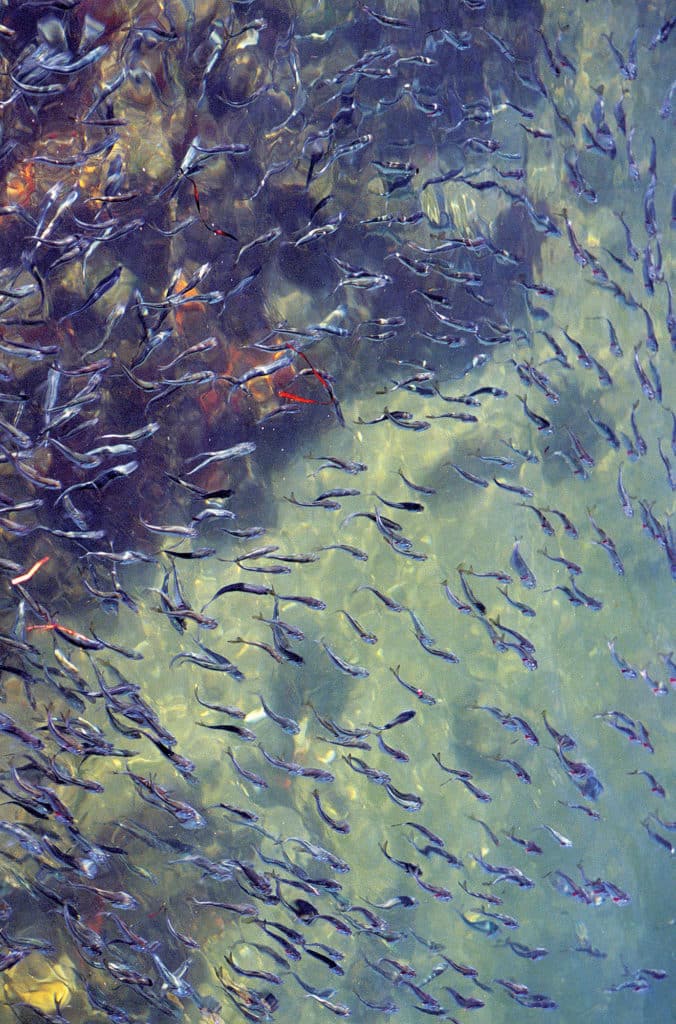
Lures the Pros Prefer
Almost any baitfish imitation produces strikes during a frenzy, but schoolies can be selective at times, and every pro has his or her favorite artificials for drawing bites.
“My all-time favorite lure,” Elser says, “is a 6- to 7½-inch Slug-Go on a light jig head. I also entice them with a 7½-inch unweighted Slug-Go, working it on the surface, rod tip up, with a walk-the-dog presentation, making a slight wake in the surface film. For anglers new to working soft plastics, I switch to hard crank baits such as the 5½-inch Rapala X-Rap. I prefer white or bone color for my artificials.
“I also enjoy working the surface with the Stillwater Smack-It popper,” Elser adds. “Last on my must-have list is a ½-ounce chartreuse Rat-L-Trap. The latter two work great when the bass are feeding on peanut bunker. When the sand eels arrive, my go-to soft plastic is a 4.6-inch Hogy Sand Eel on a weighted, 3/8-ounce swimbait hook.”
At Block Island, Willi has his schoolie favorites too. “Eighty percent of our fishing is with soft plastics due to the sand eel presence,” he says. “My go-to is the Bill Hurley Cape Cod Sand Eel in olive. We also favor the 6-inch Slug-Go in rainbow trout and the RonZ in olive. For topwater action, I like the Rebel Jumpin Minnow and Heddon Super Spook, both in bone. For swimmers, we toss a yellow or silver Magnum Bomber or a Daiwa Salt Pro Minnow.”
Tins also produce well consistently. My friend Taylor and I like flinging flat metals such as large Kastmasters or Hopkins jigs, which resemble peanut bunker, a primary forage species in bays and estuaries. Tins cast well in a stiff breeze, and hold up to small bluefish when they enter the mix.
“If you’re not having much success with a standard lure,” Merkt says, “I suggest tying a dropper fly off the leader. It simulates a baitfish chasing a smaller prey and sometimes dramatically increases productivity. The fly often outproduces the lure, and sometimes we get doubles on the same rig. For dropper flies, I like chartreuse Clouser Minnows.”
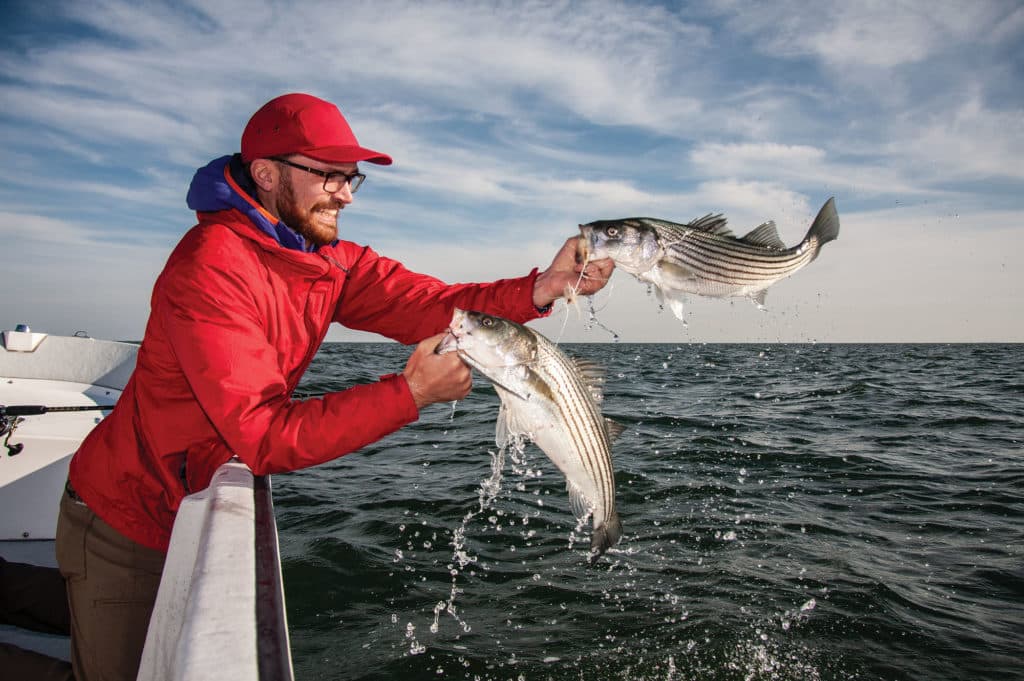
Top Tackle Picks
Elser uses a 7-foot Lamiglas TFX 7020 spinning rod with a Shimano Stradic 3000 series holding about 120 to 150 yards of 15- to 20-pound smooth, braided line. He likes the high-viz line options in the shallows to assist his anglers in tracking their lures on a windy day.
Out at Block Island, Willi’s typical light-tackle setup is a 7-foot Shimano Terez rod attached to a Shimano Sustain 4000 reel spooled with 30-pound Power Pro and 4 feet of 12- to 20-pound fluorocarbon leader fastened with a double uni-knot.
Running the Reefs
If you’re on the hunt for schoolie bass but they’re not showing on top, the most consistent place to find them is near the bottom on shallow reefs within about 4 miles of the mainland.
Pinpoint structure where the depth rises and falls abruptly. During a moving tide, motor up-current of the rip line while watching your depth finder. When the reef disappears into flat bottom, cut the motor and drift back toward the rip line.
Free-spool a small diamond or lead‑head bucktail jig until it bumps bottom, then immediately engage the reel. Retrieve a diamond about 10 cranks, drop back down, and repeat. With bucktails, pros use a standard yo-yo motion bouncing along the structure. Continue drifting until you’ve cleared the hump and covered the down-tide side of the reef. Bass often strike as the lure flutters toward the bottom, so be ready for a quick set.
Increase your chance of action by rigging any soft plastic on a 3/0 bait-holder hook attached to a dropper 12 to 18 inches above a diamond jig to simulate the predator-prey visual that Merkt suggests with dropper hook with fly. Doubles aren’t uncommon with this rig.
Read Next: Striped Bass Fishing
A good jigging outfit is a medium-action, 6½-foot rod attached to a small conventional reel like a Shimano Tekota 300 or 500. Spool it with smooth, 20-pound braid, and tie on 3 feet of 30-pound mono leader.
Back in Branford that late spring day, Taylor and I lost count after the first 30 fish, and we spent the next two hours motoring from one busting pod to the next, fighting ravenous stripers, and stopping only to change leaders or take a slug of iced tea. I’d say we released 70-plus schoolies on that tide, while keeping two 28-inchers for the skillet. And that’s no fish tale.
About the Author: Tom Migdalski is a freelance outdoor writer and photographer who has contributed to Sport Fishing for 22 years, and is author of Fishing Long Island Sound and Fishing Diamond Jigs and Bucktails. He lives in East Lyme, Connecticut, with his wife, Carol.
Striper Guides
Capt. Chris Elser
Western Long Island Sound, NY
ct-fishing.com, 203-216-7907
Capt. Dan Wood
Eastern Long Island Sound, NY
captdanwood.com, 860-442-6343
Capt. Chris Willi
Block Island, NY
bifishworks.com, 401-742-3992
Capt. Hal Herrick
Nantucket, MA
nantucketfishing.com, 508-325-1575
Year-Class and Migration Origins
“We’ve had a decline in larger fish since the mid-2000s,” says marine biologist Justin Davis, Ph.D. “But we’re optimistic for the future — 2011 had a bumper-crop spawn, and those fish are now reaching the legal length of 28 inches. In 2015 we had another bumper-crop year, and that accounts for the explosion of schoolies we’re seeing now in the 12- to 18-inch range.”
The bulk of the early-season school stripers appearing along Connecticut originates from overwintering groups in the Housatonic, Connecticut and Thames rivers. Late-spring schoolies flood the area from the Hudson River, while June fish are predominately from Chesapeake and Delaware bays.




